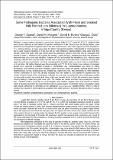| dc.description.abstract | Luanda market is located in Luanda town, Kenya. It lies 0° 0' 0" N and 34° 35' 0" E. While the Nile
perch (Lates niloticus) a fresh water fish species introduced in Lake Victoria from the family latidae, order
perciforme is widespread throughout much of the afro-tropic ecozone, where it is of great economic importance.
In L. Victoria (Kenya), in many ways when this fish is harvested it would be contaminated by microorganisms
due to poor hygienic handling or if the fish fed on food infected by microorganisms, dirty water and dirty
storage. Before this study, little was known about the pathogenic bacteria flora that may be associated with
smoked or fresh L. niloticus in the Luanda fish market, Luanda (Kenya), therefore this study was initiated to
determine their occurrence and identities. Samples of fresh and smoked fish identified to be L. niloticus were
randomly collected from Luanda market, the skin was scraped and a swab stick used to swab the fish body after
which the swab was inserted into a test tube containing 9ml.of distilled water as a stock, prior to serial dilution
in 5 test tubes. NA plates obtained were then incubated at 37°C for 24 hrs before pure cultures of emergent
growth were subjected to isolation procedures. Identification and characterization was based on colony
morphology, gram-staining technique, elevation, nature of surface, shape and opacity. Bacteria species such as
Staphylococcus aureus, Streptococcus sp., Shigella sp., Escherichia coli, and Salmonella sp. were identified.
Further examination of fresh fish samples indicated that they present a rich habitat for bacteria than fish
smoked using fire wood. Gram staining test indicated most microbes on smoked fish were mostly gram positive
and were able to retain the crystal violet color, while most bacteria found in fresh fish showed a gram negative
result by failing to retain the crystal violet color. The catalase test carried indicated that a prokaryote S. aureus
was catalase positive, while the rest of prokaryotes were catalase negative when they showed no bubbles.
Hence it became clear from this study that fish sold in Luanda market is not fit for human consumption unless
heat cooked sufficiently to eliminate all the pathogenic microorganisms’ resident therein. There is need to
conduct more studies on microorganisms associated with other body parts and other fish species sold in Luanda | en_US |

